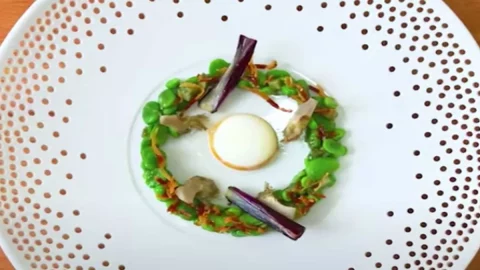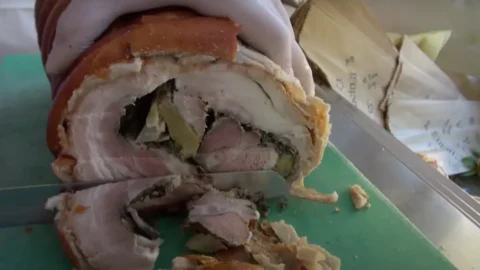Spring, just look around to admire the vital explosion of nature in the countryside covered by the luminous green of the gems, to enjoy the intense scents that are released in the crisp air, the flavors of the earth that bring with them a load of intriguing simplicity . This marvelous palette of colours, aromas and flavors finds its extraordinary synthesis in a dish of the oldest and most popular poor tradition of the countryside, Vignarola, which can express itself to the best of its gustatory and healthy properties only in this short period of the year.
Il dish was probably born in the Velletri area, a municipality in the Castelli Romani known for its extensive vineyards and vegetable gardens. There are two versions of the origins of the name. Some say that the name derives from the fact that the The vegetables needed for its preparation were those grown between the rows of vines that the peasants brought home to cook them easily in the evening, and who traces it back to the fact that in Rome the greengrocers of the markets were called "vignaroli" and that the seasonal vegetables they brought for sale in these times were broad beans, peas, lettuce, spring onions and artichokes.
The fact is that from these simple elements a masterpiece of flavors was obtained that has stood the test of time. Poor dish but extremely healthy because in those five components remarkable nutraceutical properties are condensed: broad beans, for those who can eat them, are important in promoting the proper functioning of the intestine by providing a good amount of fibres, furthermore by controlling the intestinal absorption of cholesterol and sugars they can help to counteract cardiovascular diseases and diabetes; artichokes have notoriously beneficial effects on the liver and bile with purifying properties; lettuce is a concentrate of mineral salts (potassium, calcium, phosphorus, magnesium, copper, iron and zinc) and vitamins (especially A, but also vitamins of group B, E, K, C and J); peas rich in proteins and sources of vitamins (A, E, B1, B2, B9) have the ability to reduce the levels of "bad" cholesterol, are useful for the health of the heart and the circulatory system thanks to the precious folic acid which it is an excellent anticoagulant.
And, least but not last, it's a low calorie dish in the vegetarian version, if you opt for the one enriched with bacon, just pay attention to the doses.
For the readers of Mondo Food we propose the version of Vignarola di one of the most emerging chefs of Italian catering Antonio Romano, Roman in name and in fact because he was born there 29 years ago, but of refined international culture enriched by important experiences with great masters of international cuisine in Italy and abroad. A need, that of going beyond the culinary boundaries of a fixed gastronomic conception over time, which led him, as soon as he graduated from the Hotel Institute, to go to London for an internship at the Barrafina Tapas Bar (1 Michelin star) and from here to pass through the kitchens of Dinner by Heston Blumenthal (2 Michelin stars) and seventh restaurant in the prestigious The World's 50 Best Restaurants. Just as he was in London he was reached by a telephone call from three-starred Heinz Beck who summoned him to La Pergola del Rome Cavalieri. And a special and long-lasting relationship was born with Beck, for which the great Chef has him subsequently sent to Attimi by Heinz Beck, in Milan and then to Castello di Fighine By Heinz Beck in Tuscany, where he had the exhilarating experience of seeing the Michelin star already won by the restaurant confirmed. Meanwhile young Antonio has found a way to show off at the San Pellegrino Young Chef, where he was awarded the Fine Dining Lovers Food for Tought award Italy and Southern Europe then being selected by FineDiningLovers magazine as one of the best emerging Italian chefs under 30.
Antonio Romano has recently opened a new important chapter in his professional adventure: he has been called by the Sandretto Re Rebaudengo Foundation, an institution that has supported contemporary art since 1995 and in particular the production of internationally known young artists, to direct the kitchens Of Spazio 7 the restaurant on the 1st floor of the institution's exhibition space where he inherited the baton of chef Alessandro Mecca who had captured a Michelin star here.
A space designed and created by one of the masters of contemporary minimalism: the architect and designer Claudio Silvestrin dominated by the wall painting by the Milanese artist Amedeo Martegani where a parallel is established between a constantly evolving kitchen and the works of art that animate the Foundation. A continuous exchange between art and food that translates into contemporary and experimental proposals that look with deep respect to tradition and regionality.
Antonio Romano has made attention to seasonality and the territory a categorical imperative of his cuisine which, however, combines tradition with elements borrowed from international cuisine, technology and rigor of the compositions on the plate.
Un modern approach but always respectful, as in the case of this Vignarola proposed in a surprisingly new version which nevertheless embodies all its original flavours, its values and its history but also the commitment always made by the chef in the social aspect of the kitchen, and attention to raw materials and the issue of waste (and in fact in this recipe he uses pods and cooking fat from the guanciale without throwing anything away).
“My vignarola – he says – is a dish that I created at the request of San Pellegrino during the lockdown period. My idea was to create a "starred" dish with the characteristic, however, of being easily replicable at home and with ingredients available at the supermarket since restaurants were closed at the time.
Being in Rome at the time and being of Roman origin I decided to create a dish that could be a tribute to a very popular dish.
I veered on the decision of this dish also for a question of food cost, since the lockdown was, for most people, a very difficult period also from an economic point of view ".

The Vignarola recipe
Ingredients for 2 servings:
60 g of shelled broad beans
1 artichoke
6 tufts of agretti or friar's beard
2 spring onions
60 g of shelled peas
50 g of grated pecorino romano
2 slices of pecorino romano
60 ml cream
2 yolks
4 slices of Amatrice bacon
1 clove of garlic
200 g of broad bean and pea pods
A glass of white wine
Timo
Menta
Extra virgin olive oil
Sale
Preparation:
Marinating the yolks
The night before preparation, put the yolks in two separate bowls, being careful not to break them. Add 200 ml of water and 6 g of salt to each yolk, this step will serve to make the outside of the yolk harder. Marinate the yolks in the refrigerator until the next day
Cream of peas and broad beans
On the day of preparation, shell the peas and broad beans. Set the pods aside as they will be used to prepare the sauce. First blanch the peas in boiling salted water for 30 seconds and then transfer them to water and ice to stop the cooking. This step is used to block the cooking and thus leave the peas crunchy and green. Do the same with the broad beans and then with the agretti. Since these are green vegetables, use the same cooking water for all to reduce water waste.
Remove the skins from peas and broad beans and set the vegetables aside. Centrifuge the broad bean and pea pods, then put the liquid in a saucepan and reduce until you obtain a thick sauce.
The pillow
Cut the bacon into julienne strips and put it in a hot pan. Let it fry for 6-7 minutes until crispy. Keep the cooking fat from the guanciale, it will be used to season broad beans, agretti and peas.
The artichoke
Cut the root off the spring onion so as not to damage the base and then cut it in half. Clean the artichoke, trim it, remove the leathery outer leaves and remove the inner beard, leaving it whole with part of the peeled stem. In a saucepan, fry a clove of garlic in a drizzle of oil, add a few mint leaves, add the artichoke upside down and the spring onion. Cook for a minute and then pour in the white wine. Cover with a lid and cook for 10 minutes on medium heat.
Once the artichoke is ready, cut the stem into brunoise and add it to the blanched vegetables. Cut the artichoke head into wedges.
Pecorino sauce
Prepare the pecorino sauce by putting the cream in a saucepan. Bring to the boil, turn off the heat and add the grated pecorino. Mix with a whisk until you get a sinuous sauce.
Plating
In the center of the plate, place the marinated yolk in a small pasta cup. With a wooden toothpick, delicately pierce the outside of the yolk.
Using a syringe, extract 40% of the yolk and insert the same amount of pecorino sauce using the syringe again. Do this slowly to avoid breaking the yolk. Gently remove the cookie cutter.
Place two other pastry rings of different sizes on the plate to create a sort of ring. Insert the pod sauce, the blanched and seasoned vegetables with the fat from the bacon, the spring onion, the artichoke wedges, thyme, the slices of pecorino cheese cut into triangles and the crispy bacon between the two rings.





